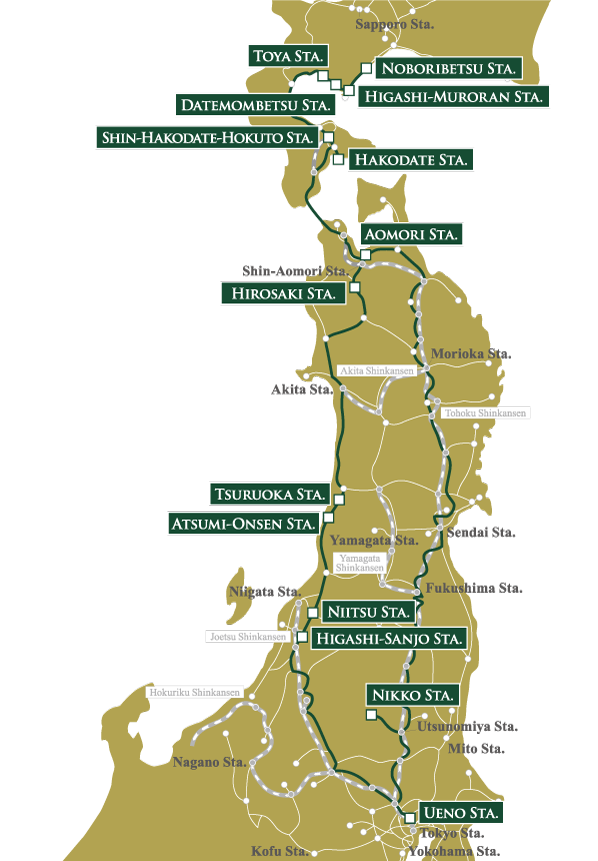4-Day/3-Night Trip
Spring-Summer
(Operated from May 2017 to Sep. 2021)
-
Witness wonderful natural scenery that evolves according to the season,
On this 4-Day/3-Night Trip, passengers departed from Ueno Station and visited Nikko, Hakodate and Southern Hokkaido
while discovering the culture and lifestyles of people living in harmony with nature.
before making our way back down the Sea of Japan coast of Honshu and returning to Ueno on the fourth day. -
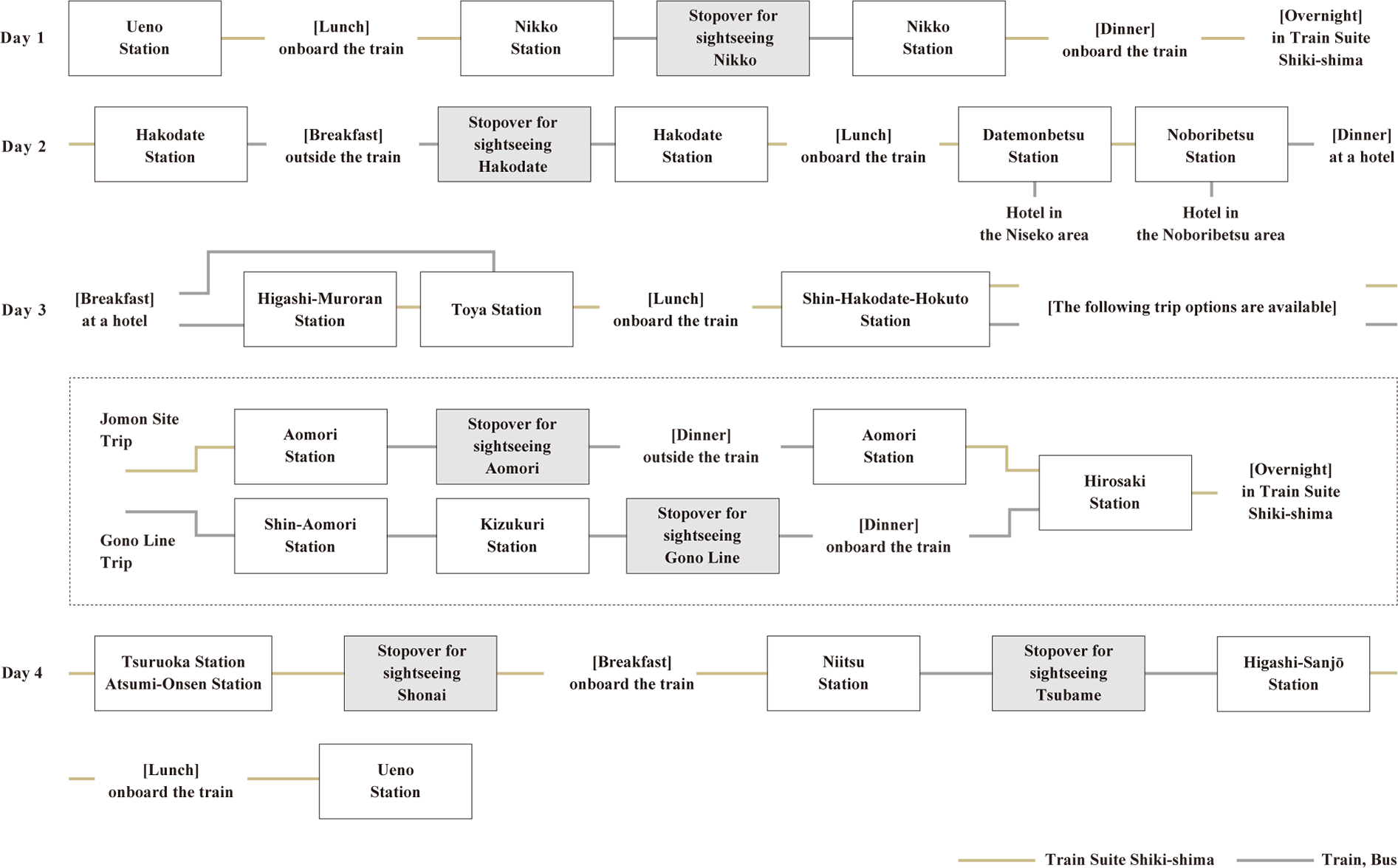
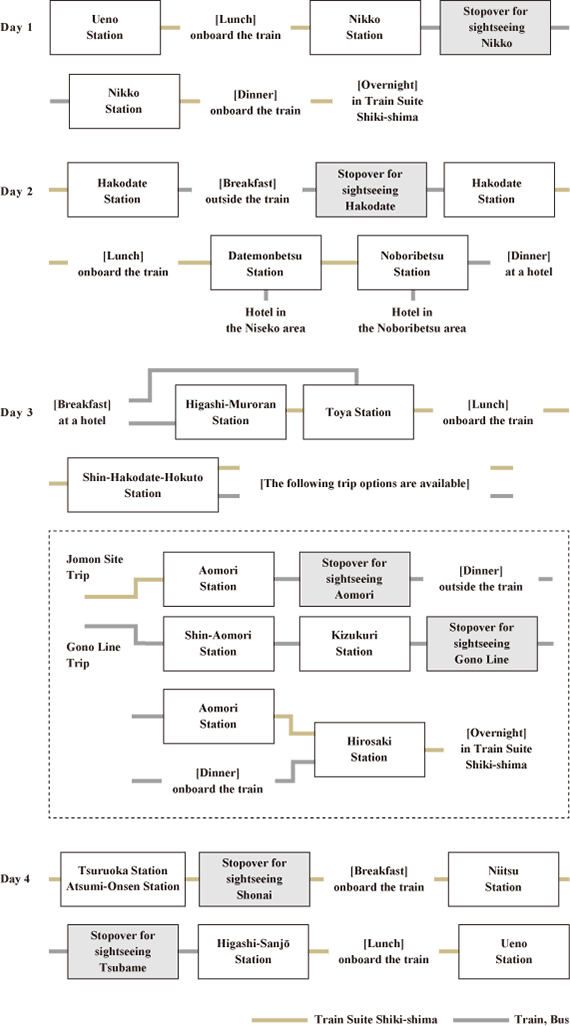
Day.1
-
[Lunch] onboard the train
-
Lunch by Kurogi (Tokyo)
- The initial meal on the TRAIN SUITE SHIKI-SHIMA was Japanese cuisine.
It came with season ingredients served in an idealistic style. -
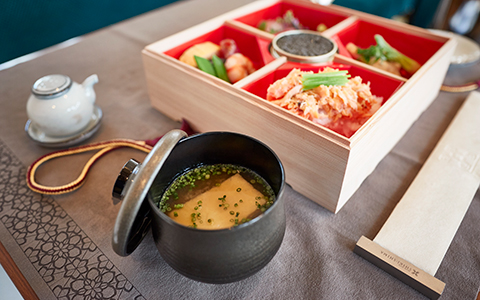
-
The essence of Tokyo-kappo cuisine livening up a trip departure
Tokyo-kappo, among the best of all Japanese cuisine, and something to be truly proud of on a global scale, is served by our chefs working at full tilt.
It is a meeting of the very best select quality materials and craftsmanship, while observing each and every ingredient with careful consideration and the finest of sensibility.
Kurogi constantly pursues the creation of “ambrosial tastes” that take full advantage of the uniqueness of all ingredients that leave a memorable impression.
On TRAIN SUITE SHIKI-SHIMA, passengers enjoyed a Shokado bento meal that was full of fine gems from Daimon Kurogi, such as rice with grilled salmon belly, in addition to dishes of the season that would liven up the atmosphere of any trip.
Kurogi dishes prepared with the utmost attention became part of the many vivid scenes on TRAIN SUITE SHIKI-SHIMA. -
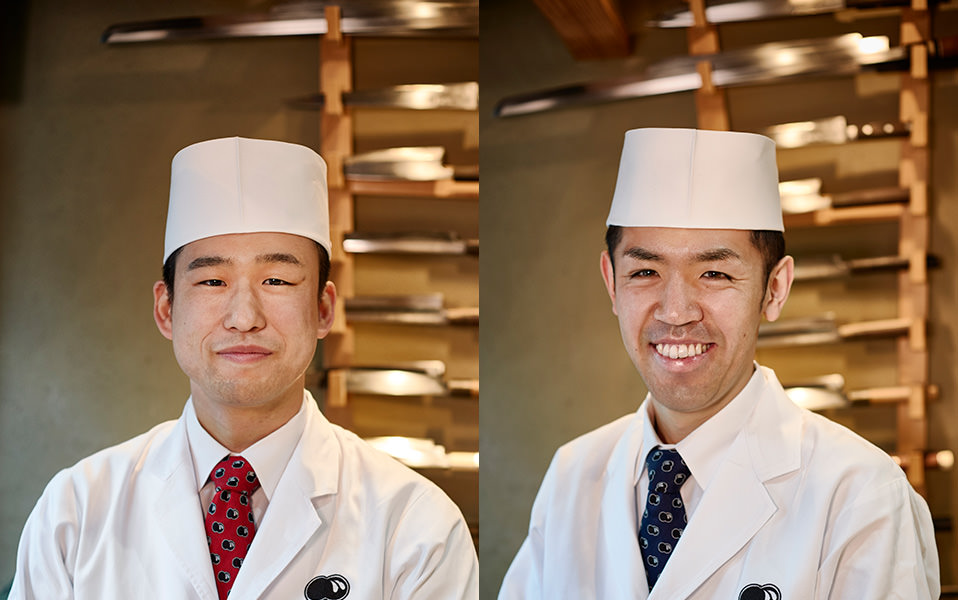
Yusuke Tomura (left) / Shingo Yoshimizu (right) Kurogi
Minato-ku/Tokyo
Arrived at Nikko Station.
They then boarded a charter bus for Shin-Yu Tan-Bo in Nikko.
-
Shin-Yu Tan-Bo in Nikko[Stopover for sightseeing]
-
SHIKI-SHIMA provided a special tour of historic sites from the Edo Period (1603-1868), which included Nikko Toshogu Shrine, a World Heritage Site commemorating the achievements of the Shogun Ieyasu Tokugawa in bringing about 260 years of peace to Japan.
Nikko Toshogu Shrine
- Passengers experienced a special TRAIN SUITE SHIKI-SHIMA itinerary as well as a visit to Yomeimon, a National Treasure of Japan which has undergone major repairs that took around four years, and the Nemuri-neko (sleeping cat) and Three Wise Monkeys wood carvings.
-
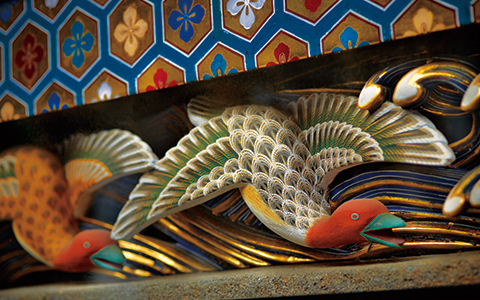
Nikko Station
- At Nikko Station, passengers witnessed the special room that was built for Emperor Taisho and the White Room, a beautiful former first class lounge decorated with white plaster walls and a chandelier.
-
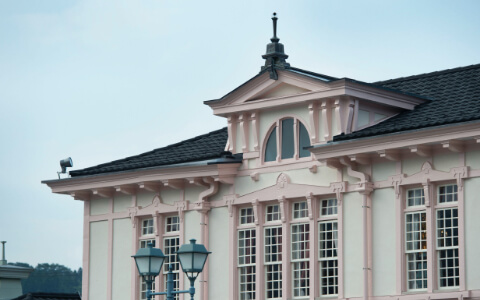
Departed Nikko Station.
-
[Dinner] onboard the train - [Overnight] on TRAIN SUITE SHIKI-SHIMA
-
Dinner prepared by TRAIN SUITE SHIKI-SHIMA executive chef Shigeru Sato
-
The dinner menu was arranged by executive chef Shigeru Sato.
The onboard meal was a special experience that was truly enjoyable. -
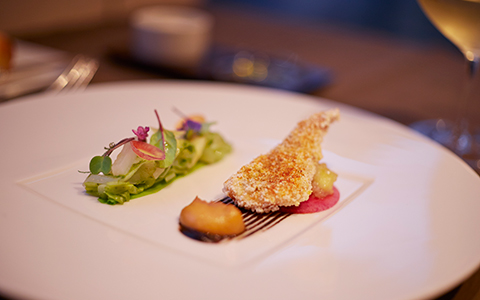
-
Building on the culinary legacy of TRAIN SUITE SHIKI-SHIMA supervisors, Nakamura and Iwasaki, I created meals of imaginative narrativity, with great attention to the ingredients and culture unique to each area.
I am from Akita in northeastern Japan, which means I have a strong commitment to always do my very best to highlight the most attractive points of each area through my cuisine. -
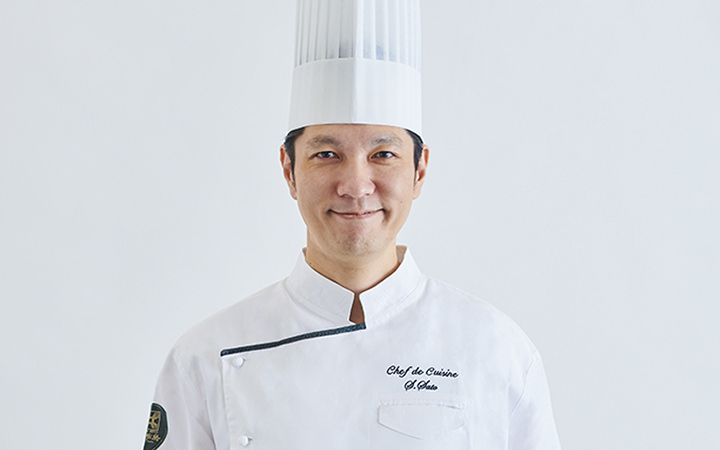
Shigeru SatoExecutive chef of TRAIN SUITE SHIKI-SHIMA
Cocktail Hour
The passengers enjoyed a drink at Lounge Komorebi in Car 5, and relaxed with a drink while watching the evening scenery from the train window.
Day.2
Arrived at Hakodate Station.
They then boarded a charter bus for Shin-Yu Tan-Bo in Hakodate.
-
Shin-Yu Tan-Bo in Hakodate[Stopover for sightseeing]
-
In Hakodate, exchange with Aomori, which lies just across the Tsugaru Strait, has flourished since the Jomon Period. The culture has been influenced by what people have brought with them from the north. Then, Hakodate became a gateway to the nation with the arrival of Commodore Perry in 1854. Passengers experienced the culture that Hokkaido’s indigenous Ainu people have so carefully preserved and the historical emaki (picture scrolls) of Hakodate, which has grown into a thriving international city.
Japanese Restaurant Fumoto
- This restaurant serves a wide variety of seasonal local Hakodate cuisine.
Passengers enjoyed some delicious seafood dishes that can only be found in Hakodate. 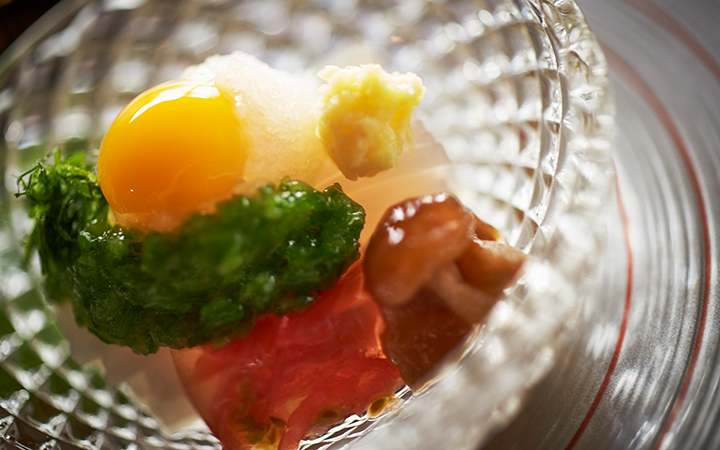
-
A breakfast of Hakodate's Famous Squid and Salmon Roe Rice Bowl
The Japanese restaurant Fumoto, whose name alludes to the foot of mount Hakodate, housed in a building constructed in the early Showa period, is frequented by locals as a place to enjoy the tastes of Hakodate.
TRAIN SUITE SHIKI-SHIMA served guests a breakfast of squid and salmon roe — seafood characteristic of Hakodate.
The ingredients for the entire year's stock of Shoyu-zuke salmon roe (salmon roe pickled in soy sauce) are caught in the waters off Hakodate during October and November each year, when salmon roe is in season.
When I was a kid, I ate squid sashimi, bought from the lady selling squid, every morning for breakfast.
We prepared various seasonal ingredients to please the refined palates of our discerning clientele. -
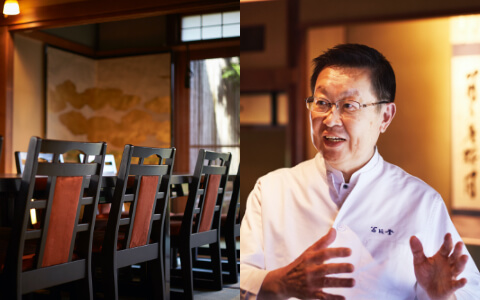
Yuji Ogata Japanese Restaurant Fumoto
Hakodate
Ainu Dance Performance
Passengers visited Gotoken, a historic long-established restaurant that opened in 1879.
They enjoyed an exciting dance performance featuring the traditional culture of indigenous Ainu people, which has been passed down through the generations.
Hakodate City Museum of Northern Peoples
Opened in what was previously the Hakodate branch of the Bank of Japan, the museum has precious artifacts outlining a history of the northern peoples.
Trams (Hakodate Shiden)
- Passengers took a special trip to Hakodate Station on a retro tram, an exclusive offer of this tour.
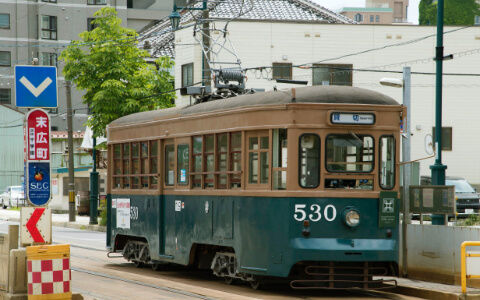
Departed Hakodate Station.
-
[Lunch] onboard the train
-
Lunch prepared by chef Yuya Sekikawa of Climat (Hokuto)
- The meal was prepared using only the finest local ingredients, including vegetables, meats, cheeses and eggs. Passengers experienced the culture of southern Hokkaido while dining on its very best cuisine.
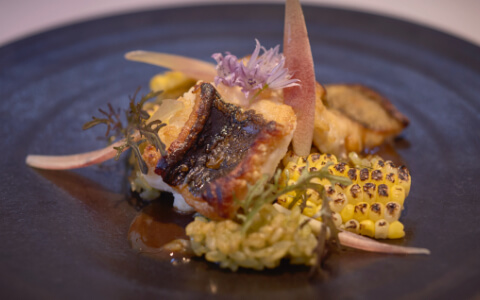
-
French cuisine expressing the "climate" of Hakodate
The style of climat is to build up each plate one at a time, with advice and ingredients, such as vegetables, mutton, pork, beef, cheese and eggs, supplied by colleagues who are almost family.
I love to prepare meals that convey the climate and culture of southern Hokkaido.
They gave passengers on TRAIN SUITE SHIKI-SHIMA the feeling of really being in Hakodate.
I’ve lived in Hakodate since I was born, and like it more than any other city I’ve visited. With the mountains and sea so near, it’s a place that makes you glad to be alive.
My chief desire was for guests to come away with the same feeling. -
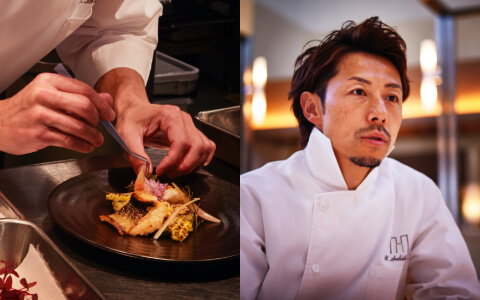
Yuya Sekikawa climat
Hokuto / Hokkaido
Select an accommodation on the 2nd day
-
Niseko Trip
Arrived at Datemonbetsu Station.
Passengers arrived at Datemombetsu Station.
They then boarded a charter bus to Niseko Konbuonsen Tsuruga Bessou Mokunosho in Konbu Hot Springs or Zaborin in Hanazono Hot Springs in Niseko.-
Niseko KonbuonsenTsuruga Bessou Mokunosho
-
The blessings of the earth, Plentiful Niseko Vegetables
- Located in the resort area of Niseko, and wrapped in warmth from the surrounding trees, our hot spring and inn greet visitors with the promise of a relaxing stay in a second home.
Meals are based around seasonal vegetables like potatoes, asparagus, mushrooms and edible wild plants. Sashimi caught in the nearby coastal waters is accompanied by fresh vegetables.
Guests loved the Takikomi gohan (mixed rice), made with local rankoshi rice and lily bulbs.
They also liked gathering around the fireplace in the evenings to roast marshmallows.
TRAIN SUITE SHIKI-SHIMA passengers enjoyed their stay in a Japanese inn as a distinct experience from the time they enjoyed onboard the train. -
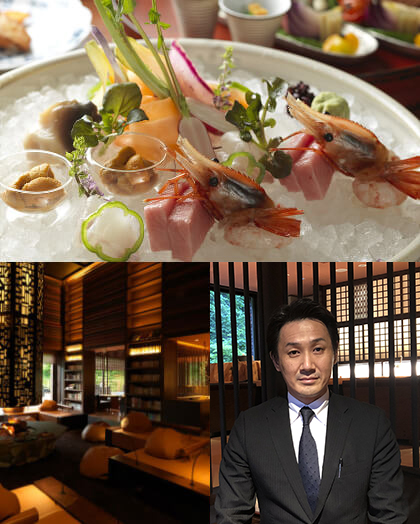
Akihiro Takeo Tsuruga Bessou Mokunosho
Niseko / Hokkaido
-
Zaborin
-
Taste the whole of Hokkaido in our Northern Kaiseki
- An inn standing in the middle of a primeval forest.
This is a place where you can come together with nature and feel the changing of the seasons.
There are just 15 rooms, each spacious and equipped with a continuously-flowing 100% natural spring water spa.
The meals were prepared by a native Hokkaido chef using home-grown vegetables paired with edible wild plants and mushrooms collected by the staff forager.
Passengers enjoyed our "Northern Kaiseki" Japanese-style meals — as beautiful as paintings, and with a delicate flavor to match.
We're sure these satisfied even TRAIN SUITE SHIKI-SHIMA passengers, well versed in various foods in Japan and around the world. -
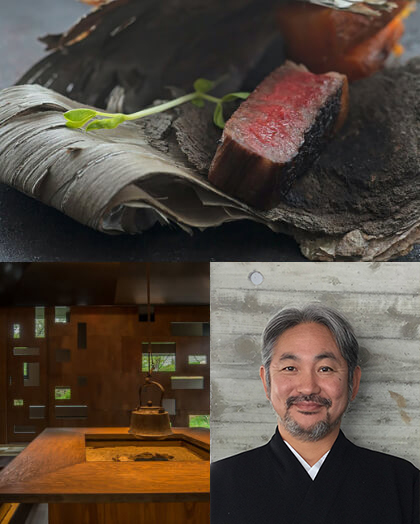
Kenichi Wataru Zaborin
Niseko / Hokkaido
-
-
Noboribetsu-Onsen Trip
Arrived at Noboribetsu Station.
Passengers arrived at Noboribetsu Station.
They then boarded a charter bus for Shin-Yu Tan-Bo in Noboribetsu.-
Shin-Yu Tan-Bo in Noboribetsu[Stopover for sightseeing]
-
Hell Valley
Passengers watched a traditional performance played in front of a "hellscape" created with volcanic activity as its backdrop.
-
Noboribetsu Onsenkyo Takinoya in Noboribetsu Hot Springs.
-
Hot Springs and Cuisine Found Only in Noboribetsu
- Noboribetsu has so many varieties of hot springs that it is often called a "hot-spring department store".
Takinoya itself has four different kinds, including a radium spring and a table salt spring.
TRAIN SUITE SHIKI-SHIMA passengers took a break in the middle of their journey to soak comfortably in the hot waters, and enjoyed delicious food amidst the gardens and forest planted by our first proprietor.
For dinner, in addition to fresh sashimi and horsehair crab, they enjoyed a fruity desert that has received high praise.
Breakfast included rice, eggs, natto and other choice foods characteristic of a Japanese inn. -
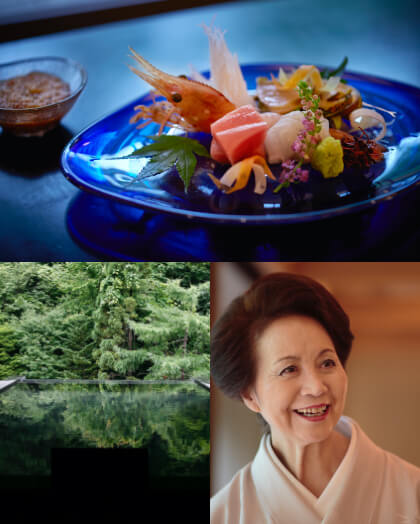
Noriko Suga Noboribetsu Onsenkyo Takinoya
Noboribetsu / Hokkaido
-
Day.3
-
Departed Mokunosho and Zaborin
Passengers boarded a charter bus from Mokunosho and Zaborin to travel to Shin-Yu Tan-Bo in Niseko.-
Shin-Yu Tan-Bo in Niseko[Stopover for sightseeing]
-
Yama no Marche ("Mountain Market")
Niseko Sahina Campground was featured in Honto ni Kimochi Ii Kyampujo (Truly Excellent Campgrounds) in 2002. Here, passengers enjoyed some local produce and other specialties while learning from the area's producers.
-
-
Departed Noboribetsu Onsenkyo Takinoya
Passengers boarded a charter bus to depart Takinoya.Departed Higashi-Muroran Station.
Departed Toya Station.
-
[Lunch] onboard the train
-
Lunch by Molière Café "Come Rain or Come Shine" (Sapporo)
- Sapporo’s Café Molière “Come Rain or Come Shine” serves French cuisine full of the rustic flavor of the finest Hokkaido ingredients. Here, no expenses were spared to provide passengers with a high-quality French lunch for their last meal in Hokkaido.
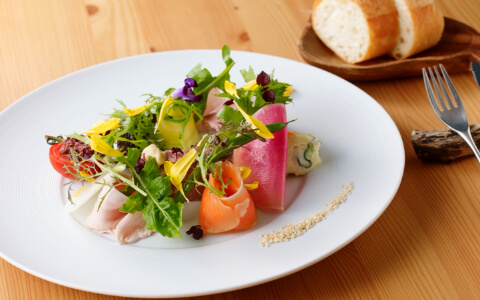
-
Hokkaido, to be enjoyed with all five senses
The restaurant opened as affiliated restaurant of Molière, French restaurant in Sapporo.
It has a homely atmosphere where guests feel welcome.
The open kitchen is in full view of all, and offered so much pleasure to enjoy dining with vision in addition to a great taste.
One of our greatest joys is serving dishes that one can always enjoy regardless of rain or shine, whether on a special day or not, and make them one of the greatest of memories on a TRAIN SUITE SHIKI-SHIMA trip. -
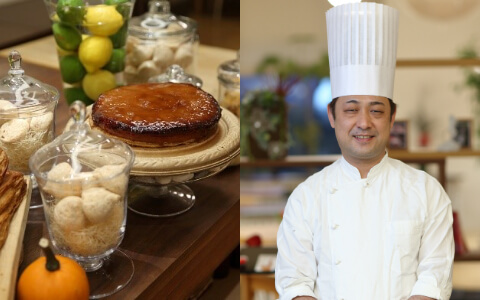
Keiji Miyata Molière Café
"Come Rain or Come Shine"
Sapporo City / Hokkaido
Arrived at Shin-Hakodate-Hokuto Station.
Select a trip
-
Jomon Trip
Arrived at Aomori Station.
Passengers arrived at Aomori Station.
They then boarded a charter bus for Shin-Yu Tan-Bo Jomon Trip.-
Shin-Yu Tan-Bo Jomon Trip[Stopover for sightseeing]
-
Passengers explored restored buildings dating back to the Jomon Period (11,000-300 BC) to experience romance of ancient times from five thousand years ago.
Sannai-Maruyama Site
The Sannai-Maruyama Site is Japan's largest ruins, dating back to the Jomon Period.
On this tour, while being led by a guide, passengers were able to view the ruins while an excavation was in progress.-
[Dinner] outside the train
-
Dinner prepared by chef Masanori Kawaguchi of Hotel Jogakura (Aomori)
- Dinner was served at the Aomori Museum of Art, which owns vast stage backdrops painted by Chagall.
Passengers enjoyed delicious French cuisine prepared by accomplished chef Masanori Kawaguchi from Hotel Jogakura at the foot of Mt. Hakkoda. 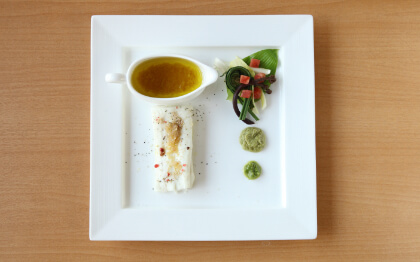
Experience a French Take on the Many Flavors of the Land and Sea of Aomori
- I am the head chef at Hotel Jogakura, one of the top resort hotels in the Hakkoda-san Mountains.
I grew up in Aomori, and have been intimately familiar with the Tsugaru area ever since I was a young child.
I make use of the training I received and the experience I gained in Tokyo and France to craft French-style dishes that make the most of ingredients unique to the mountains and waters of Aomori.
The sea in this area is blessed with whitefish and scallops, while Lake Jusanko provides clams and freshwater fish.
The region also boasts a wide variety of medicinally effective wild vegetables and herbs such as garlic, as well as Kuraishi brand beef, a bountiful variety of apples, and many more Aomori delights.
These were all used in the delicious menu for TRAIN SUITE SHIKI-SHIMA. -
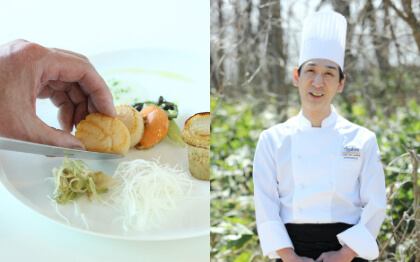
Masanori Kawaguchi Head Chef, Hotel Jogakura
Aomori
-
-
Gono Line Trip
Departed Shin-Hakodate-Hokuto Station.
Passengers arrived at Shin-Hakodate-Hokuto Station.
They then to Shin-Aomori Station on the Hokkaido Shinkansen.Arrived at Shin-Aomori Station.
Passengers arrived at Shin-Aomori Station. They then boarded a charter bus for Shin-Yu Tan-Bo Gono Line Trip.-
Shin-Yu Tan-Bo Gono Line Trip[Stopover for sightseeing]
-
Passengers boarded the Hokkaido Shinkansen Hayabusa from Shin-Hakodate-Hokuto Station to Shin-Aomori Station. They then boarded the Resort Shirakami charter train from Kizukuri Station.
Tachineputa no Yakata
Tachineputa is the largest summer festival in the region, taking place in Goshogawara every August.
In the museum, passengers viewed the almost 20m-high floats used in the parade.-
[Dinner] onboard the train
-
Dinner prepared by chef Hiroki Takamura of Japanese Restaurant Takamura (Akita)
- Japanese Restaurant Takamura serves Japanese cuisine preserving all the traditions of Edo cuisine. Passengers enjoyed dishes prepared by head chef Hiroki Takamura, together with some local sake.
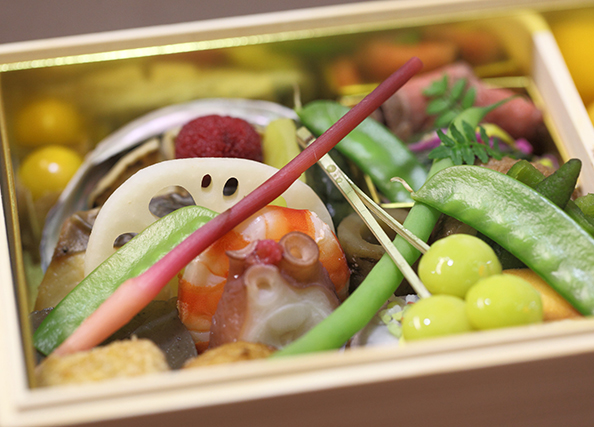
Preserving the Essence of Edo Cuisine in Akita
- At 28, after training in the historic Takohachi restaurant in Mejiro Tokyo, I returned to my hometown in Akita to open my own store.
Instead of changing the flavors and techniques learned from my master, I strive to preserve traditional Edo cuisine here in Akita. Back in the Edo period, Edo (Tokyo) must have seemed like a foreign country to people coming in from the countryside.
My restaurant's style is to create that same feeling by using western ingredients in Edo cuisine.
Not gaudy or showy, but beautiful.
*Provided onboard the Resort Shirakami train. -
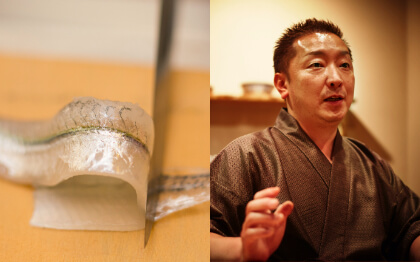
Hiroki Takamura Japanese Restaurant Takamura
Akita
-
Departed Hirosaki Station.
-
[Overnight] on TRAIN SUITE SHIKI-SHIMA
-
Cocktail Hour
The passengers enjoyed a drink at Lounge Komorebi in Car 5, and relaxed with a drink while watching the evening scenery from the train window.
Day.4
Arrived at Tsuruoka Station, Arrived at Atsumi-Onsen Station.
They then boarded a charter bus for Shin-Yu Tan-Bo in Shonai (Three activities).
-
Shin-Yu Tan-Bo in Shonai: Three Activities[Stopover for sightseeing]
-
Passengers arrived at Tsuruoka, Yamagata in the morning.
Passengers chose from three different activities: ①Watching jellyfish floating dreamily in Kamo Aquarium, ②taking a morning bath at Atsumi Hot Springs, a site visited by many historic figures including the famous poet Matsuo Basho, or ③observing the making of shina-ori cloth, one of Japan's three oldest weaving styles that uses thread made from tree bark fibers.
Departed Atsumi-Onsen Station.
-
[Breakfast] onboard the train
-
Breakfast prepared by chef Masayuki Okuda of Al-ché-cciano (Tsuruoka)
- The Shonai region of Yamagata is renowned for its bountiful seafood and mountain vegetables.
Passengers enjoyed a sumptuous breakfast making the most of Shonai delicious foodstuff. 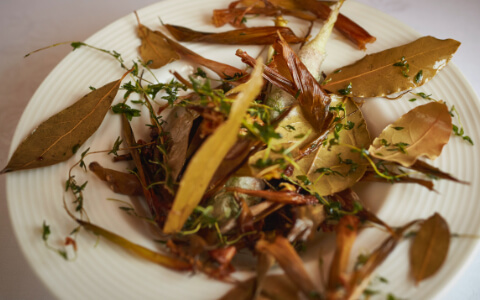
-
World Class Breakfast in Shonai, the Capital of Food
The diverse terrain of Shounai in Yamagata is blessed with the riches of both the sea and the mountains.
It has garnered attention for its rich variety of ingredients, with various fruits and vegetables produced year-round. Cradled by Mt. Chōkai and the Three Mountains of Dewa, the Shonai Plain area produces a diverse array of vegetables and livestock.
Cold and warm currents mix at Shounai beach on the sea of Japan, attracting around 130 species, including local fish in season, into the nets of local fishermen.
Using these ingredients from Shounai, I aimed to create the world's finest breakfast. Passengers enjoyed a perfect moment as they watched the morning break over the Sea of Japan. -
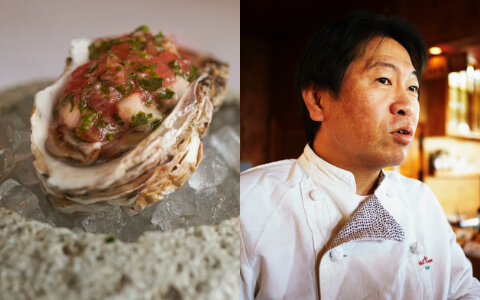
Masayuki Okuda Al-ché-cciano
Tsuruoka, Yamagata
Arrived at Niitsu Station.
They then boarded a charter bus for Shin-Yu Tan-Bo in Tsubame.
-
Shin-Yu Tan-Bo in Tsubame[Stopover for sightseeing]
-
Tsubame, Niigata is a craftsperson's town that is world-famous for silverware, including the cutlery used for the Nobel Prize banquet. At the journey's final stop, passengers experienced the tradition and elegance of this world-famous Japanese craft.
Gyokusendo
- Gyokusendo is a hammered copper studio that has honed its skills in molding copper using a metal hammer for close to 200 years.
Passengers enjoyed observing this traditional craft. 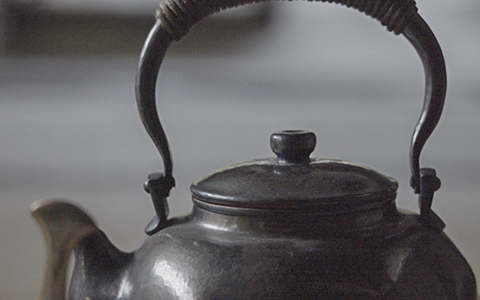
Departed Higashi-Sanjo Station.
-
[Lunch] onboard the train
-
Lunch of Niigata’s Special Kiwami Sushi prepared by Niigata Sushi Masters
Passengers enjoyed sushi with seasonal Niigata ingredients prepared by sushi masters Toshiya Yoshizawa from Sekaizushi, Norio Yokoyama from Sushi Cuisine Marui and Toichi Yamada from Sushiyasu.
The delicious taste of locally sourced fish takes center stage when it comes to Niigata sushi, which the passengers experienced first-hand.
-
Bringing "Kiwami", the Essence of Niigata Sushi, to Even Greater Heights
"Kiwami" is a standard dish provided by the "Niigata prefecture sushi guild", a voluntary association in Niigata prefecture.
Kiwami was created with the concept of making it easy to sample Niigata's seasonal delicacies.
It features fish emblematic of Niigata such as black throat sea perch, fatty tuna and northern pink prawn, plus sea urchin, salmon roe, and other local seasonal fish all eaten with a premiere fish sauce.
On TRAIN SUITE SHIKI-SHIMA, this "Kiwami" was condensed into a dish that further heightened the distinct flavor of Niigata sushi.
Guests enjoyed the same fresh-made sushi served in my restaurant as they watch the landscape roll by outside the car window. -
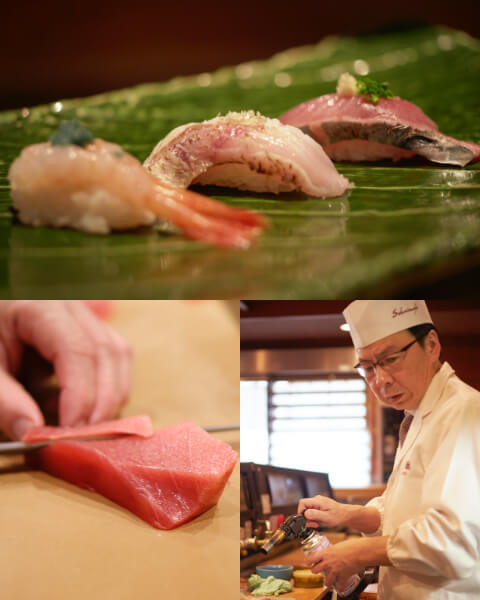
Toshiya Yoshizawa Sekaisushi
Niigata
-
The unaltered flavor of Nabechaya Street in Niigata's Furumachi
For over forty years, I've run a restaurant on Nabechaya street in Furumachi — a place that still recalls the traditional pleasure quarters of Niigata.
With "always the highest level of freshness" as my motto, first thing each morning I visit the market in the city at Myogadani to select whitefish like black throat sea perch, northern pink prawn, Sado tuna, etc. Also, this year we have begun to use specially grown traditional koshihikari rice.
I'm sure one can taste the difference in the flavor of the sushi rice.
Passengers enjoyed the taste of Niigata sushi, backed by tradition and formality. -
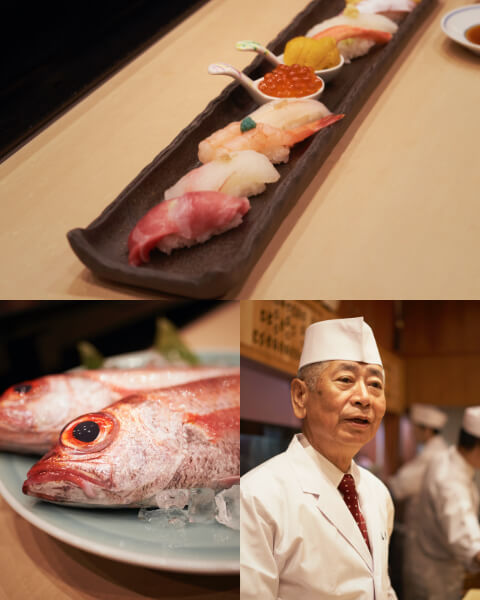
Norio Yokoyama Sushi Cuisine Marui
Niigata
-
Seasonal Niigata Fish, Edomae Style
Sushiyasu's style is to bring out various flavors of sushi made in the Tokyo Style of work I learned from my father before me.
The fatty tuna is topped with a dollop of aromatic Shizuoka wasabi, and the red tuna is marinated.
The northern pink prawn is eaten with fish sauce.
Passengers enjoyed arrangements that capitalized on the flavor of whitefish like olive flounder and fivespot flounder seasoned with shio-ponzu (sea salt and citrus sauce), kimo-shoyu (soy sauce with fish liver), etc. They also tried our hikarimono bo-zushi (rod-shaped sushi topped with large slice of silvery fish), and our castella rolled omelet.
Finally, they enjoyed the lightly seasoned elegant small nigiri sushi — perfect for the end of a journey. -
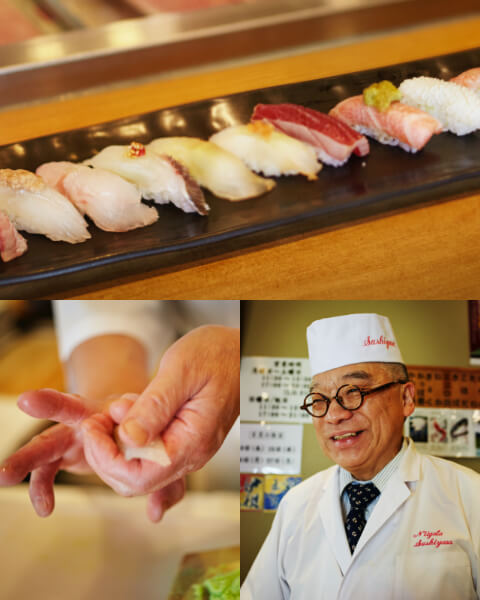
Toichi Yamada Sushiyasu
Niigata
Arrived at Ueno Station.
Passengers enjoyed the company of the train crew and their fellow travelers one final time, while reflecting on their wonderful journey aboard TRAIN SUITE SHIKI-SHIMA.
TRAIN SUITE SHIKI-SHIMA
